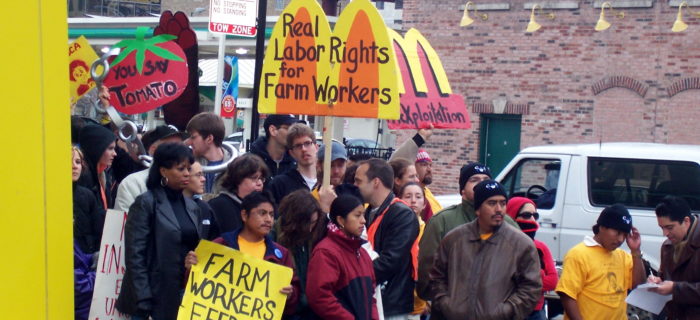This Thanksgiving, Remember the People’s History of Our Food
“Afterwards they (as many as were able) began to plant their corn, in which service Squanto [Tisquantum] stood them in great stead, showing them both the manner how to set it, and after how to dress and tend it. Also he told them except they got fish and set with it (in these old grounds) it would come to nothing, and he showed them that in the middle of April they should have store enough come up the brook, by which they began to build, and taught them how to take it, and where to get other provisions; all which they found true by trial and experience.”
– Of Plymouth Plantation, 1604 –16271
Tisquantum’s act of solidarity is an emblematic preface to 500 years of agrarian transformation in North America. How did a starving, inept band of pilgrims manage to introduce the explosive process of colonization and nation-building that would set the stage for the globe’s most powerful food regime in history?
The short answer is: they didn’t.
It wasn’t the original colonists who transformed North America; it was wave upon wave of dispossessed British, Nordic, and European peasants. The Old World’s “agrarian transition” privatized the rural commons, destroyed village life… It also uprooted millions of peasants. This provided a cheap, reserve army of labor to fuel the Industrial Revolution. It also threw masses of desperate villagers—willing to risk all for a new life—into the colonial cauldron of the Americas.
When mercantile magnates and emerging industrialists forced Europe’s excess agricultural population to colonize the Atlantic coast of North America, the first pilgrims perished by the hundreds until the indigenous inhabitants—who were farmers and lived in towns—taught them to farm, fish, and hunt. These Native Americans would come to regret this humanitarian gesture: they lost nearly 1.5 billion acres of land to white settlers. After the first wave of genocide and dispossession, enslaved Africans were brought to work the tobacco and cotton plantations. The tremendous profits of slave agriculture filled bank coffers in London, Boston, and New York. Slavery became central to the construction of US capitalism—and the capitalist food system.
Slavery, indentured servitude, and genocidal dispossession laid the foundation for the emergence of capitalist agriculture—a new form of production and consumption that emerged in the transition from agrarian to industrial society. Beginning with the enclosures of the commons in Britain and the forced migration of the peasantry to urban factories and the colonies, from as early as the sixteenth century, the agrarian transition has always entailed a violent restructuring of environment, production, and society.
The rural landscape of the United States has been thousands of years in the making. The transformation of indigenously-managed gardens, woodlands, marshes, drylands and prairies into industrial farms of globally-traded commodity crops and concentrated animal feeding operations (CAFOs) has been dramatic.
Despite its abundance, our food system leaves many people poor, hungry and malnourished, leading to widespread protests and social struggles for equity, sustainability, and the right to food itself.
Stay in the loop with Food First!
Get our independent analysis, research, and other publications you care about to your inbox for free!
Sign up today!We need to repopulate the countryside, not empty it. We have to invest to improve the quality of rural life, not just extract its wealth. We must break up and redistribute large plantations and implement agroecology on a small and medium scale in order to restore the environment, cool the planet, and ensure a decent income to rural people. We need to open up farming in the city, instead of paving over farmland.
This Thanksgiving, let’s give thanks to the food on our table—food for which one in seven people in the world (including in the United States)—do not have secure access. Let’s also recognize the peoples and communities whose histories made—and continue to make—our food system. Let’s celebrate the producers and workers who bring us our food. Let’s also stand in solidarity with the women and men who are working tirelessly to cultivate justice in our food system, to the farmers fighting for food sovereignty—for the food activists standing up for the right to good, healthy, sustainably- produced food that feeds all our communities and regenerates our planet. It is the relationships in the food system, and how we govern them, that really matter.
It’s time to share the table.
1. Bradford, William. 1656. “Surviving the First Winter of the Plymouth Colony, 1620-1621.” Excerpt. Washington, DC. Accessed 11/19/2016. https://nationalhumanitiescenter.org/pds/amerbegin/settlement/text1/BradfordPlymouthPlantation.pdf
This blog was adapted from Land Justice: Re-Imagining Land, Food, and the Commons in the United States.


 Help Food First to continue growing an informed, transformative, and flourishing food movement.
Help Food First to continue growing an informed, transformative, and flourishing food movement.




